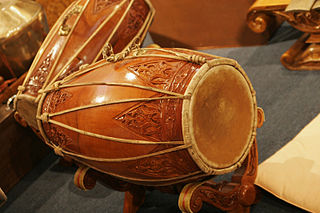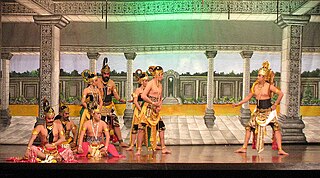Related Research Articles

Gamelan is the traditional ensemble music of the Javanese, Sundanese, and Balinese peoples of Indonesia, made up predominantly of percussive instruments. The most common instruments used are metallophones played by mallets and a set of hand-played drums called kendhang/Kendang, which register the beat. The kemanak and gangsa are commonly used gamelan instruments in Bali. Other instruments include xylophones, bamboo flutes, a bowed instrument called a rebab, a zither-like instrument siter and vocalists named sindhen (female) or gerong (male).

Societal attitudes toward homosexuality vary greatly across different cultures and historical periods, as do attitudes toward sexual desire, activity and relationships in general. All cultures have their own values regarding appropriate and inappropriate sexuality; some sanction same-sex love and sexuality, while others may disapprove of such activities in part. As with heterosexual behaviour, different sets of prescriptions and proscriptions may be given to individuals according to their gender, age, social status or social class.

The angklung is a musical instrument from the Sundanese people in Indonesia made of a varying number of bamboo tubes attached to a bamboo frame. The tubes are carved to have a resonant pitch when struck and are tuned to octaves, similar to Western handbells. The base of the frame is held in one hand, while the other hand shakes the instrument, causing a repeating note to sound. Each performer in an angklung ensemble is typically responsible for just one pitch, sounding their individual angklung at the appropriate times to produce complete melodies.

Wayang, also known as wajang, is a traditional form of puppet theatre play originating from the Indonesian island of Java. Wayang refers to the entire dramatic show. Sometimes the leather puppet itself is referred to as wayang. Performances of wayang puppet theatre are accompanied by a gamelan orchestra in Java, and by gender wayang in Bali. The dramatic stories depict mythologies, such as episodes from the Hindu epics the Ramayana and the Mahabharata, as well as local adaptations of cultural legends. Traditionally, a wayang is played out in a ritualized midnight-to-dawn show by a dalang, an artist and spiritual leader; people watch the show from both sides of the screen.

The rebab is the name of several related string instruments that independently spread via Islamic trading routes over much of North Africa, Southeast Asia, the Middle East, and parts of Europe. The instrument is typically bowed, but is sometimes plucked. It is one of the earliest known bowed instruments, named no later than the 8th century, and is the parent of many bowed and stringed instruments.

The slenthem is an Indonesian metallophone which makes up part of a Javanese gamelan orchestra. The slenthem is part of the gendér family. It consists of a set of bronze keys comprising a single octave: there are six keys when playing the slendro scale and seven when playing the pelog. These keys are suspended by leather cords over individual bamboo tube resonators in a wooden frame, which are cut so that the placement of the bamboo's node causes the functional length of the resonator to be shorter for higher notes. The instrument is played by striking the keys with a mallet, called a tabuh, which has a short handle and a thin wooden disk edged in cloth or rubber. One hand is left free to dampen notes. It is a low-pitched instrument with a softer sound than the saron demung.

Kendang or Gendang is a two-headed drum used by people from the Indonesian Archipelago. Kendang is one of the primary instruments used in the Gamelan ensembles of Javanese, Sundanese, and Balinese, the Kendang ensemble as well as various Kulintang ensembles in Indonesia, Brunei, Malaysia, Singapore, and the Philippines. It is constructed in a variety of ways by different ethnic groups. It is a relation to the Indian mridangam double-headed drum.

The dhalang or dalang is the puppeteer in an Indonesian wayang performance.

The mirwās or marwas, plural marāwīs is a small double-sided, high-pithced hand drum originally from the Middle East. It is a popular instrument in the Arab States of the Persian Gulf, used in sawt and fijiri music. It is also common in Kuwait and Yemen.

Reog or Réyog is a traditional Indonesian dance in an open arena that serves as folk entertainment, contains magical elements, the main dancer is a lion-headed person with a peacock feather decoration, plus several masked dancers and Kuda Lumping. Reog is one of the performing arts from the northwestern region of East Java and Ponorogo is the region where Reog originated. The city gate of Ponorogo is decorated with warok and gemblak, two characters who were present at the time when Reog is performed. Reog is one of Indonesia culture that is still very strong with mystical elements and mysticism.

Kuda Lumping is a traditional Javanese dance originated from Ponorogo, East Java, Indonesia depicting a group of horsemen. Dancers "ride" horses made from woven bamboo and decorated with colorful paints and cloth. Generally, the dance portrays troops riding horses, but another type of Kuda Lumping performance also incorporates trances and magic tricks. When the "possessed" dancer is performing the dance in trance conditions, he can display unusual abilities, such as eating glass and resistance to the effects of whipping or hot coals.

Gandrung is a traditional dance from Indonesia. Gandrung has many variations and is popular in Bali, Lombok and Eastern Java among the Balinese, Sasak and Javanese. The most popular variation is gandrung from the Banyuwangi region in the eastern peninsula of Java, so much that the city is often referred as Kota Gandrung or "the city of gandrung". Originally a ritual dance dedicated to the goddess of rice and fertility, Dewi Sri, it is currently performed as a social dance of courtship and love in communal and social events, or as a tourist attraction. Gandrung Sewu Festival is held at Banyuwangi annually.
Homosexuality in Indonesia is generally considered a taboo subject by both Indonesian civil society and the government. Public discussion of homosexuality in Indonesia has been inhibited because human sexuality in any form is rarely discussed or depicted openly. Traditional religious mores tend to disapprove of homosexuality and cross-dressing.

Sundanese dances is a dance tradition that is a part of ritual, artistic expression as well as entertainment and social conduct among the Sundanese people of West Java and Banten, Indonesia. Sundanese dance is usually cheerful, dynamic and expressive, with flowing movements in-sync with the beat of kendang accompanied with Gamelan degung music ensemble.

Singo Ulung is one of the original traditional dances from Bondowoso regency, East Java, Indonesia. The dance is played by two people in a lion-like costume and accompanied by music.
Margaret Joy Kartomi is an Australian ethnomusicologist who is known especially for her contributions to the study of Asian music. She is an emeritus professor of Monash University in Melbourne. She specialises in the music of Indonesia and Southeast Asia.

Barong dance is a style of traditional Balinese from Bali, Indonesia. The dance demonstrates about the mythological depiction of animals that have supernatural powers and could protect humans. Barong is the king of the spirits, leader of the hosts of good, and enemy of Rangda, the demon queen and mother of all spirit guarders in the mythological traditions of Bali. The Barong dance featured battle between Barong and Rangda to represent the eternal battle between good and evil.

Gendang Beleq dance is a sacred folk dance tradition of Sasak people of Lombok in West Nusa Tenggara, Indonesia. This dance demonstrates dance performance with big drums, called gendang beleq.

Indonesian theatre is a type of art in the form of drama performances that are staged on a stage, with a distinct Indonesian nuance or background. In general, theatre is an art that emphasizes the performing arts that are displayed in front of a large crowd. In other words, theater is a form of visualisation of a drama that is staged on the stage and watched by the audience. Indonesian theatre includes the performing arts of traditional theater and modern theatre located in the territory of Indonesia. Some examples of Indonesian theater are Arja, Wayang, Wayang wong, Lenong, Ludruk, Janger, Randai and others. Theatre in Indonesia can also be referred to as regional or ethnic theatre, because it originates and develops from 1,300 ethnic cultures in Indonesia.

Sisingaan or also known as Gotong Singa, Singa Ungkleuk, Singa Depok, Kuda Ungkleuk, Pergosi or Odong-odong, is a traditional Sundanese lion dance originated from Subang, West Java, Indonesia. This lion dance performance marked by a form of an ark or palanquin that resembles a lion. The lion ark or lion-shaped effigy is carried by a group of dancers who perform various attractions accompanied by traditional music. The lion palanquin is being ride by a children. This dance usually performed to celebrate the child's circumcision ceremony, where the child is carried on a lion around the kampung (village).
References
- ↑ "On gender diversity in Indonesia". The Conversation . 12 September 2018. Retrieved 24 August 2020.
- ↑ Izharuddin, Alicia (2011). "Melancholic Masculinity and Representations of Traditional Homoeroticism in an Indonesian Novel". In Ramello, Stefano (ed.). Fascination of Queer. Oxfordshire: Interdisciplinary Press. pp. 69–78. ISBN 9781848880795.
- ↑ Kartomi, Margaret J. (1976). "Performance, Music, and Meaning of Reyog Ponorogo". Indonesia. 22 (22): 85–130. doi:10.2307/3350979. hdl: 1813/53628 . JSTOR 3350979.
- ↑ De Lyon, J. B. M. (1941). "Over de Waroks en Gemblaks van Poronogo". Koloniale Tijdschrift: 740–60.
- ↑ Groenendael, Clara van (2008). Jaranan: The Horse Dance and Trance in East Java. Verhandelingen van het Koninklijk Instituut voor Taal-, Land- en Volkenkunde. Brill. pp. 22–25. ISBN 9789004253872.